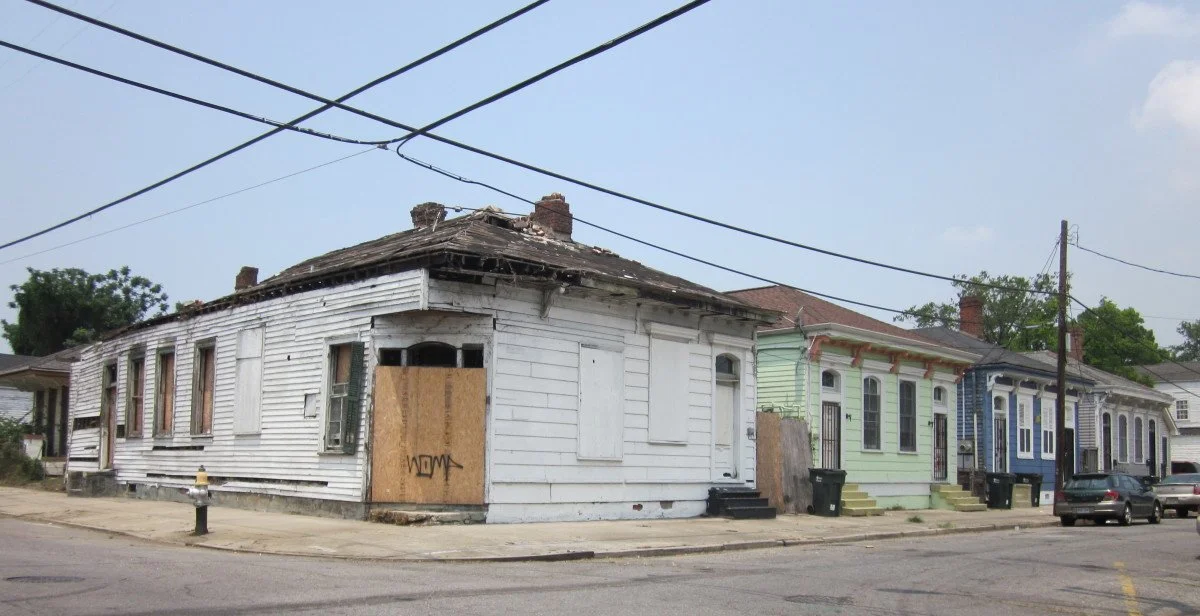Boarded up corner store in New Orleans
First off, let’s be clear in the terminology. Banks don’t invest. A bank will sell you a construction loan to build/rebuild if you and an investor put up 20-30% of the project cost. A bank will sell you a mortgage to retire the construction loan for 70-80% of what the building is worth once it is completed and leased.
Banks don’t invest. Banks lend money, secured by an asset the can sell to recover their loan amount if you default on the loan and the have to foreclose. Banks are not doing you a favor. They need to sell you a loan. That’s how they make fee income. That’s a big part of their business model. A loan officer on base salary plus bonus is basically a commissioned salesperson. (They are just selling loans and not automobiles).
Banks do not invest. An investment carries significant risk that you will lose your principal. It is not secured, collateralized, or guarantied. It is not insured against loss.
When a bank sells you a construction loan to build or renovate a building, or a mortgage on a completed building, those loans are secured with the borrower's asset, something the bank can take in the event the borrower defaults on the loan, along with a personal guaranty from the borrower that the bank can enforce if the foreclosure and sale of the asset does not cover the amount of the loan.
Where they make loans and on what kinds of projects varies from bank to bank, but again, banks are not making investments. They are selling loans funded by their depositors cash or cash they borrowed from the Federal Home Loan Bank or similar institutions. They have to maintain loss reserves of 10% against the loans they make. The cash their shareholder's have invested in the bank is used for those required loss reserves.
Now, if your question is "Will banks sell loans to people working in downtrodden areas?" my answer is yes, but the terms of those loans will be adjusted based upon the risk of a default the bank's underwriters see in the downtrodden area.
Those loans will require robust guarantees from individuals with significant net worth. Those loans will probably be for 50-65% of project costs or an even smaller portion of the capital stack because appraisers need comparable sales of building values in the area to comply with the standards of their practice.
If you are one of the first people building/rebuilding in a distressed neighborhood, you will be more likely to use private lenders and equity to do the first couple projects to establish data that can be used by the local appraisers. Banks are required to use the appraiser's opinion of value as the starting point for underwriting the loan. The opinion of value establishes what the asset is worth in case they get it back and have to dump it in a quick sale.
Early developers take on the risk that the distressed neighborhood may not support rents sufficient to support the costs of new construction, which is why we recommend that small developers focused upon the distressed neighborhood start small, with something they can live in if necessary.
Distressed neighborhoods typically need more than supportive appraisals, investment of social capital, the time and attention of the small local developer become the basis for building trust. Find work for folks in the neighborhood. Connect your rookie plumber with a decent bookkeeper, pick up trash and litter on the regular without fanfare.
The trust of your neighbors is a competitive advantage for the small operator for when the big developers from the other side of town or from out of town show up because the small developers have done the heavy lifting of proving the market and establishing comparable sales and NOI/cap rate data for the appraisers to use for larger deals.
The people who already live in distressed neighborhoods are in a position to learn the skills required to build/rebuild is they start small and build a culture of local collaboration. Investors invest. There is no shortage of folks willing to invest in a sound real estate project with a solid operating partner. An investor with a connection to a distressed neighborhood may have personal reasons for wanting to invest there.



